Abstract
The release of two locally formed vasodilators, adenosine and prostacyclin (PGI2), from hearts subjected to different degrees of hypoxia was investigated. Isolated rabbit hearts were perfused according to Langendorff with Tyrode solution, saturated with gas mixtures containing 8-95% O2 and 5% CO2 in N2. Coronary flow rate, O2 extraction and uptake, and cardiac production of lactate, purines and 6-keto-PGF1 alpha (the stable metabolite of PGI2) were determined. During perfusion of the hearts with a solution saturated with 95% O2, release of lactate, 6-keto-PGF1 alpha and purines was very low: lactate was liberated at a rate of about 5 mumol/100 g . min, purine release corresponded to 2% of the total adenosine nucleotide content of the heart per hour and the release of 6-keto-PGF1 alpha was about 150 mumol/100 g . min. During hypoxia there was a graded release of lactate and purines from the heart, as well as a liberation of 6-keto-PGF1 alpha. Mild hypoxia (60% O2 in the gas mixture) elicited a 160% increase in the formation of lactate and a 40% increase in the release of purines. During severe hypoxia (8% O2 in the gas mixture) the release of lactate and purines increased by more than 2000%. In contrast, the release of 6-keto-PGF1 alpha never increased more than 80% at any degree of hypoxia, neither did it correlate to the severity of the hypoxia. From these data we conclude that of the two vasodilating agents formed in the heart, adenosine and prostacyclin, the former is probably more important in the regulation of coronary flow.
Full text
PDF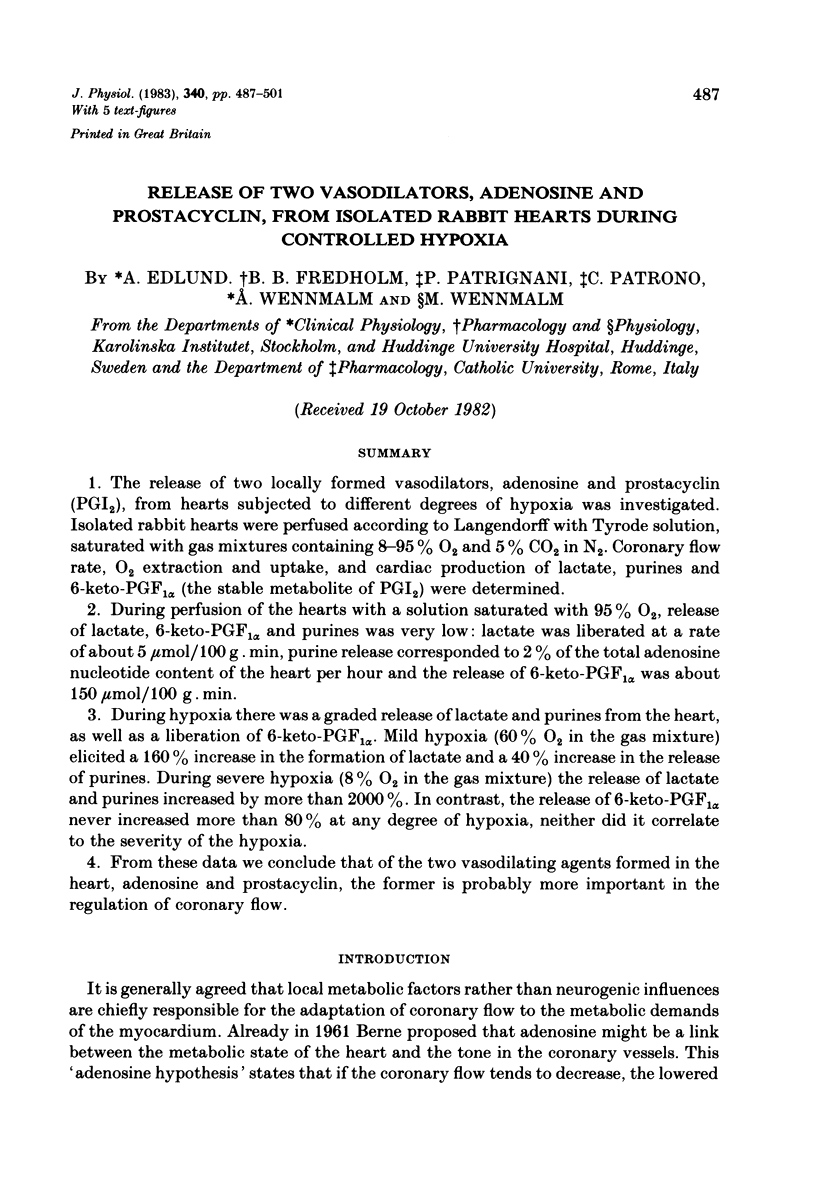
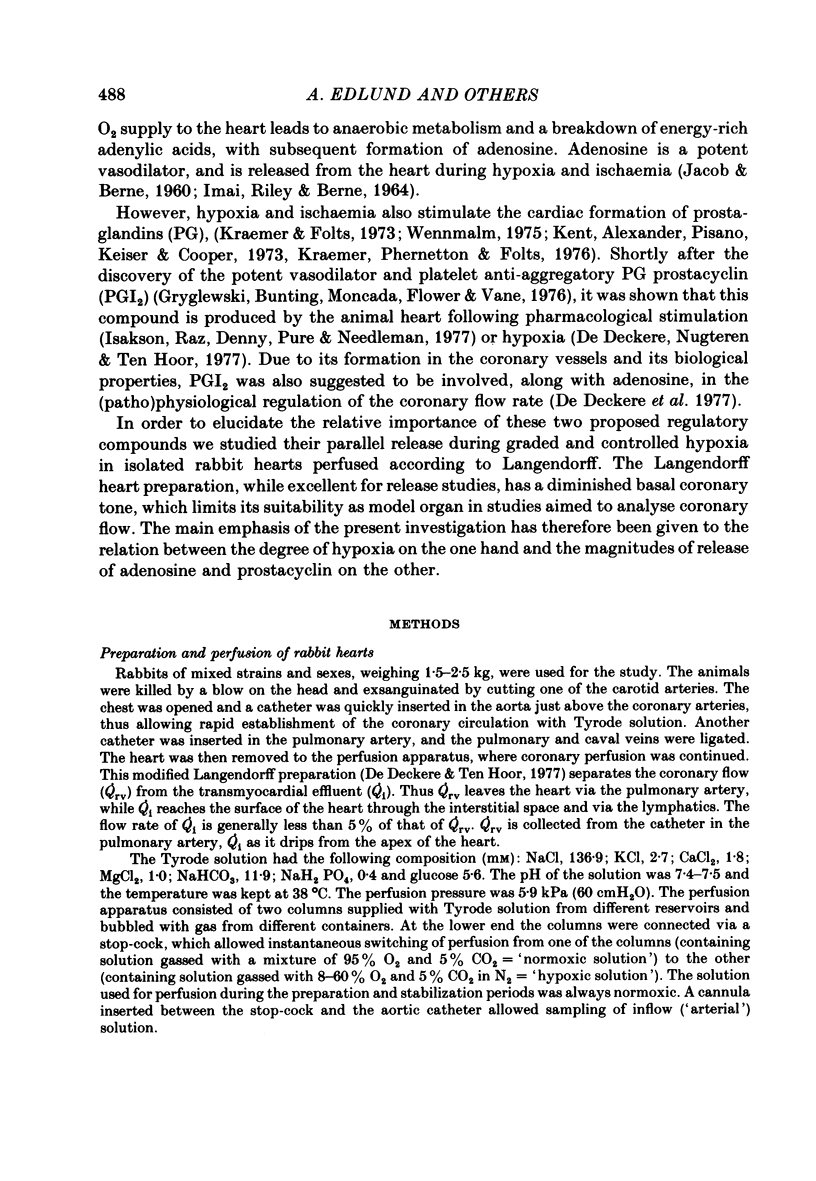
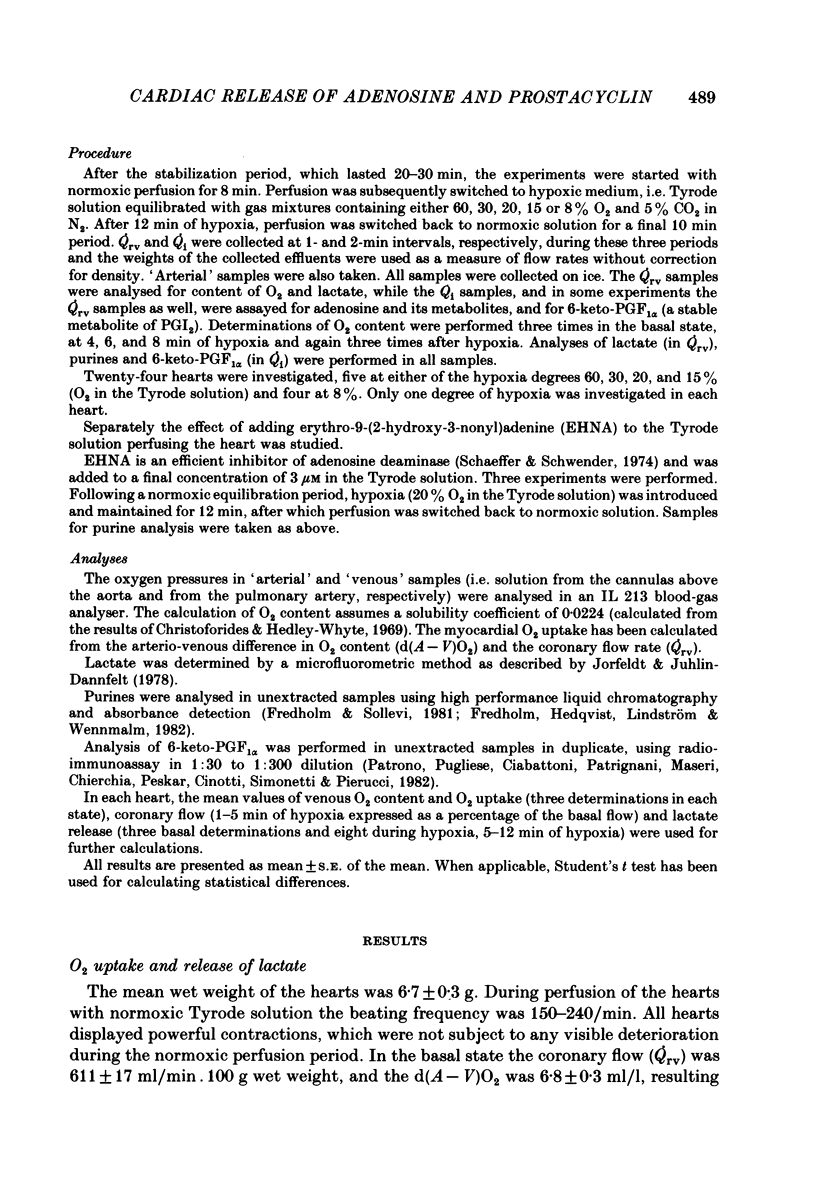
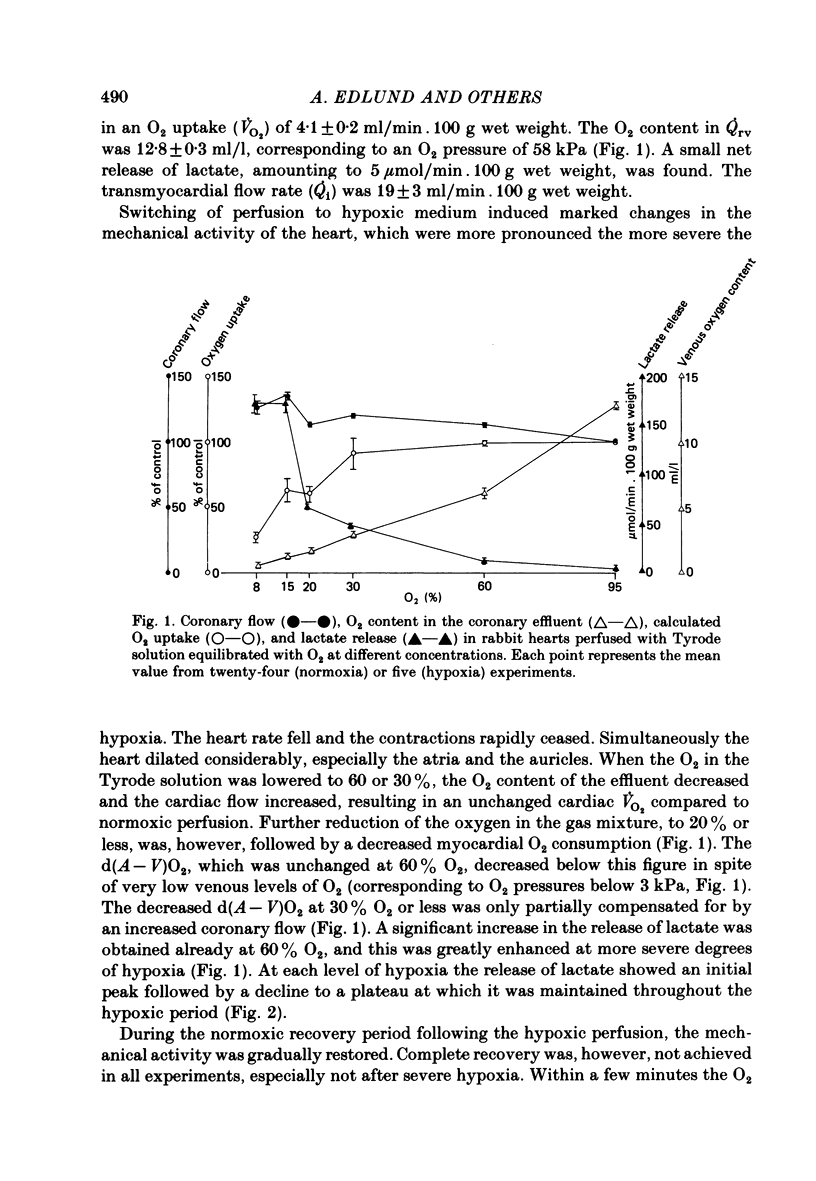
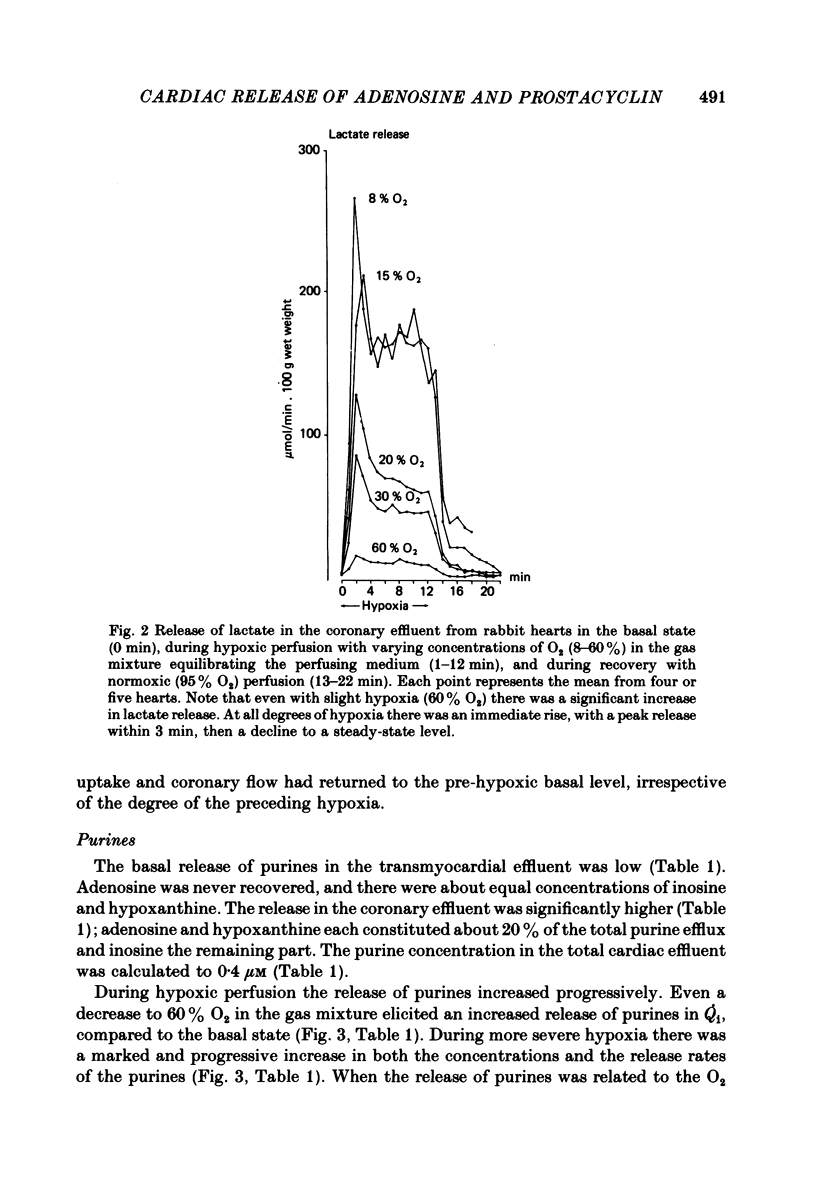
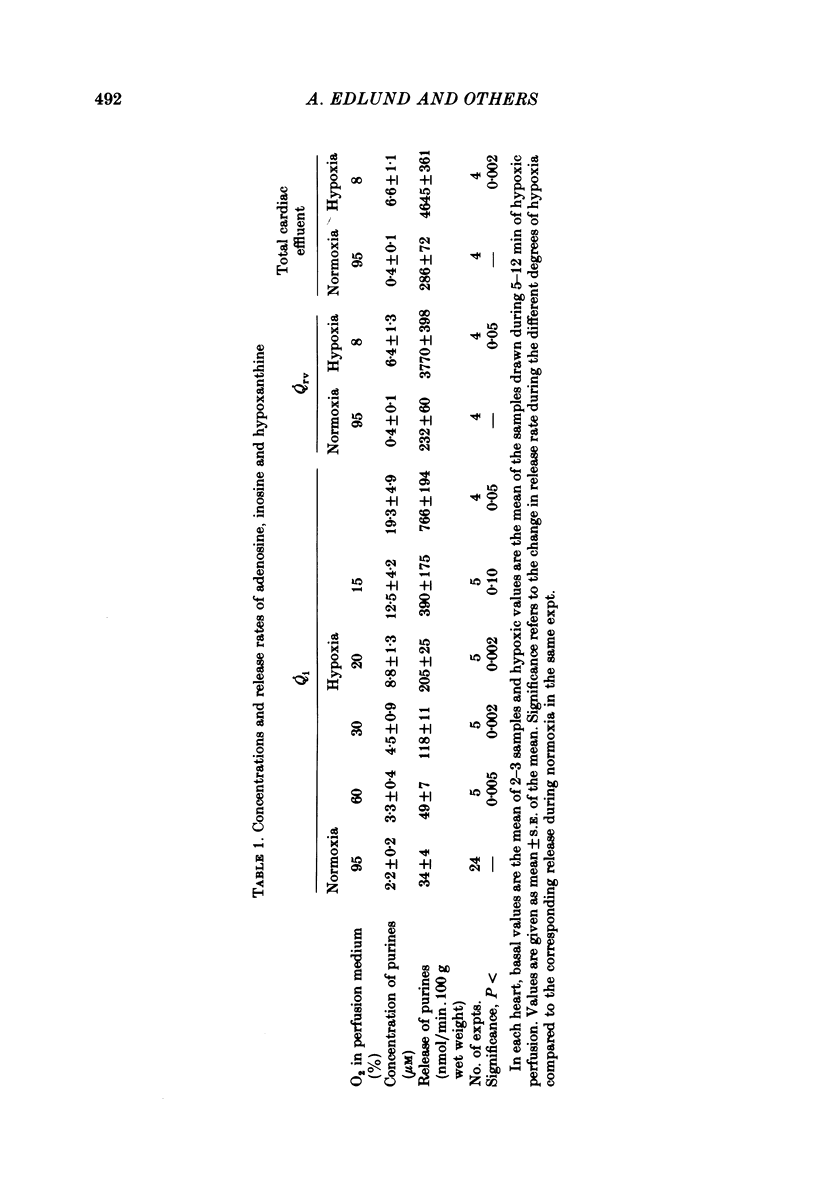
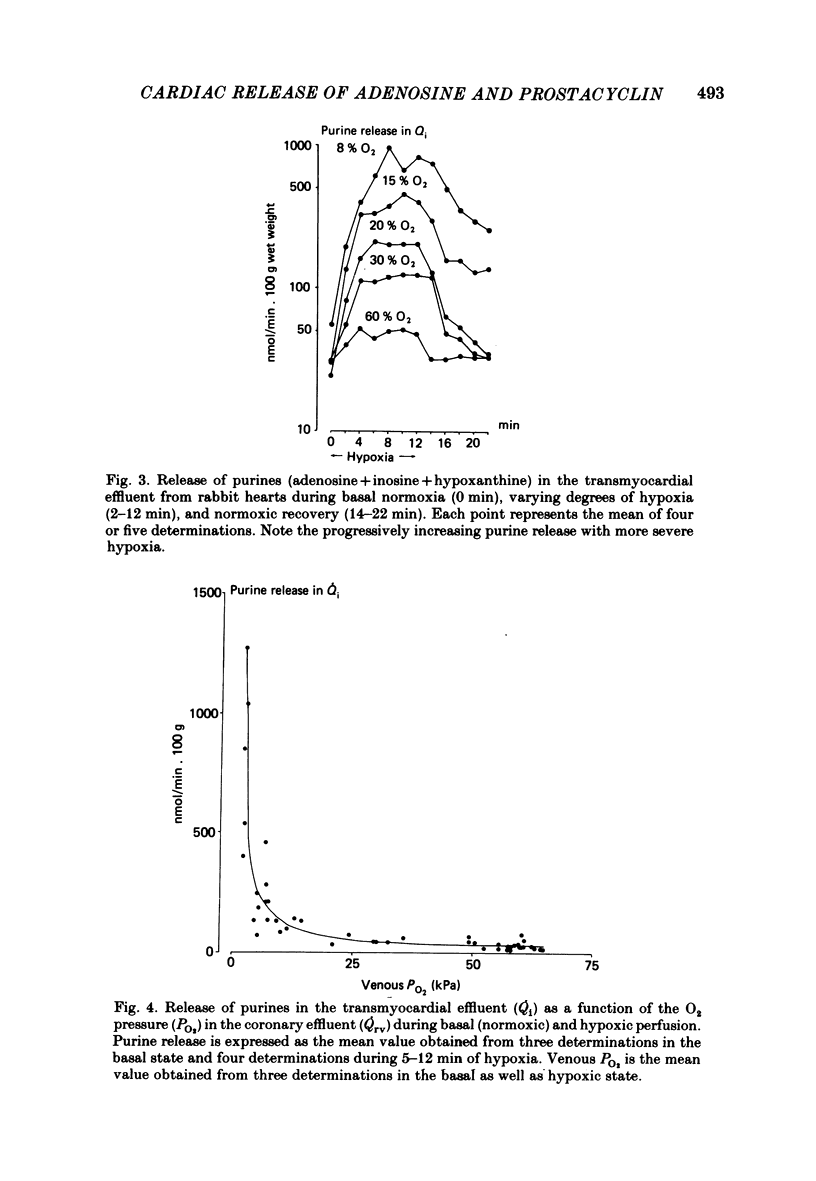
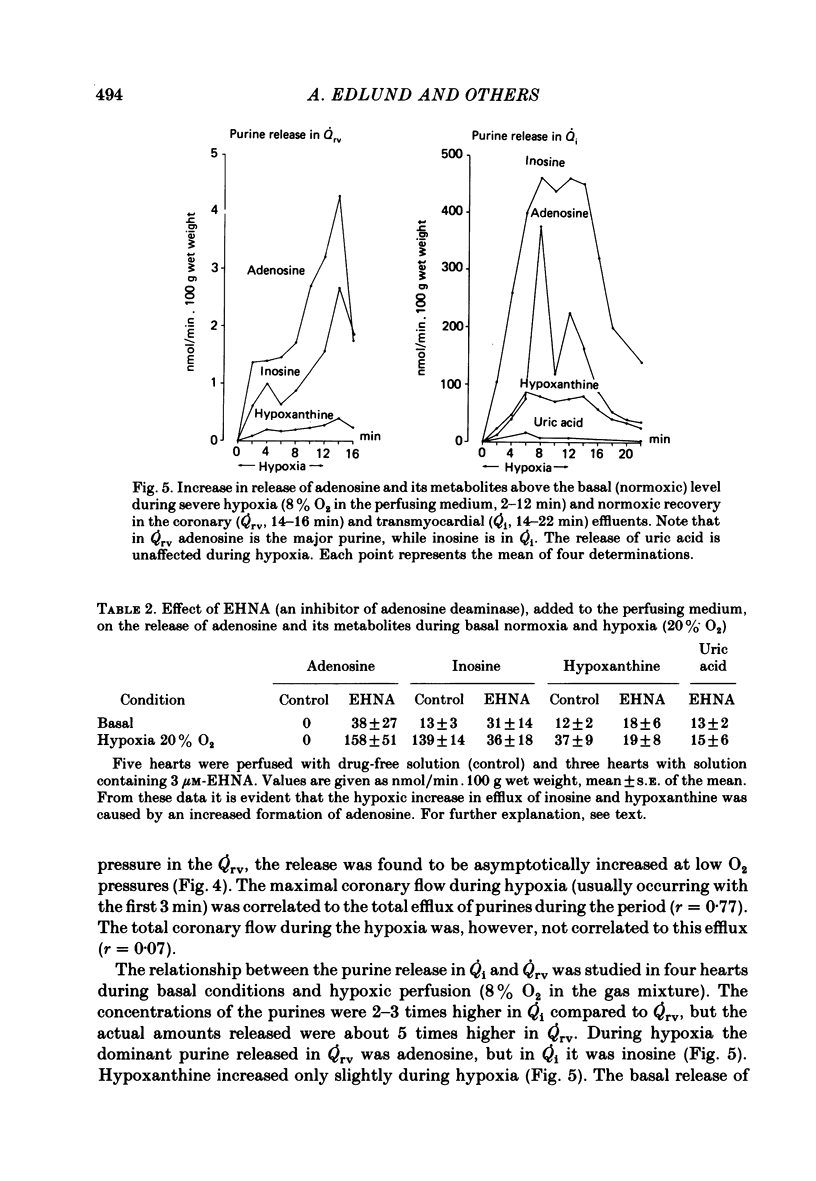
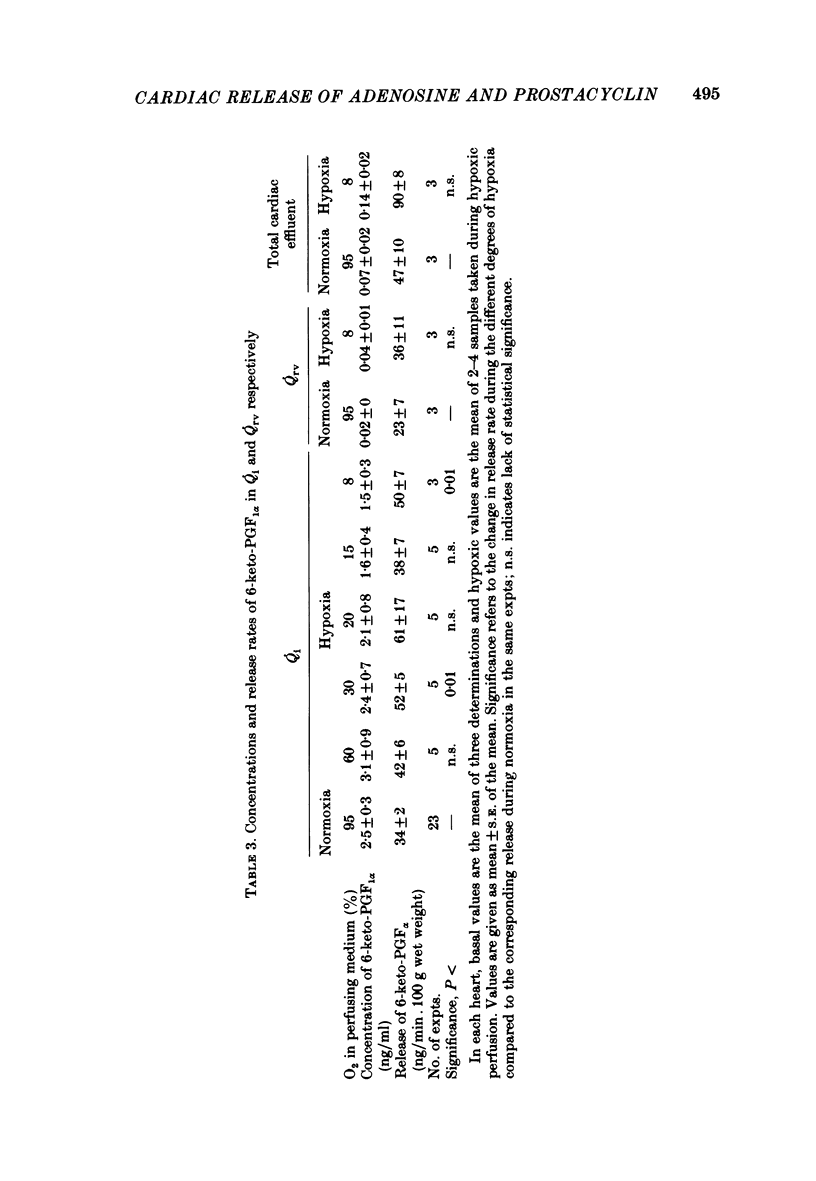
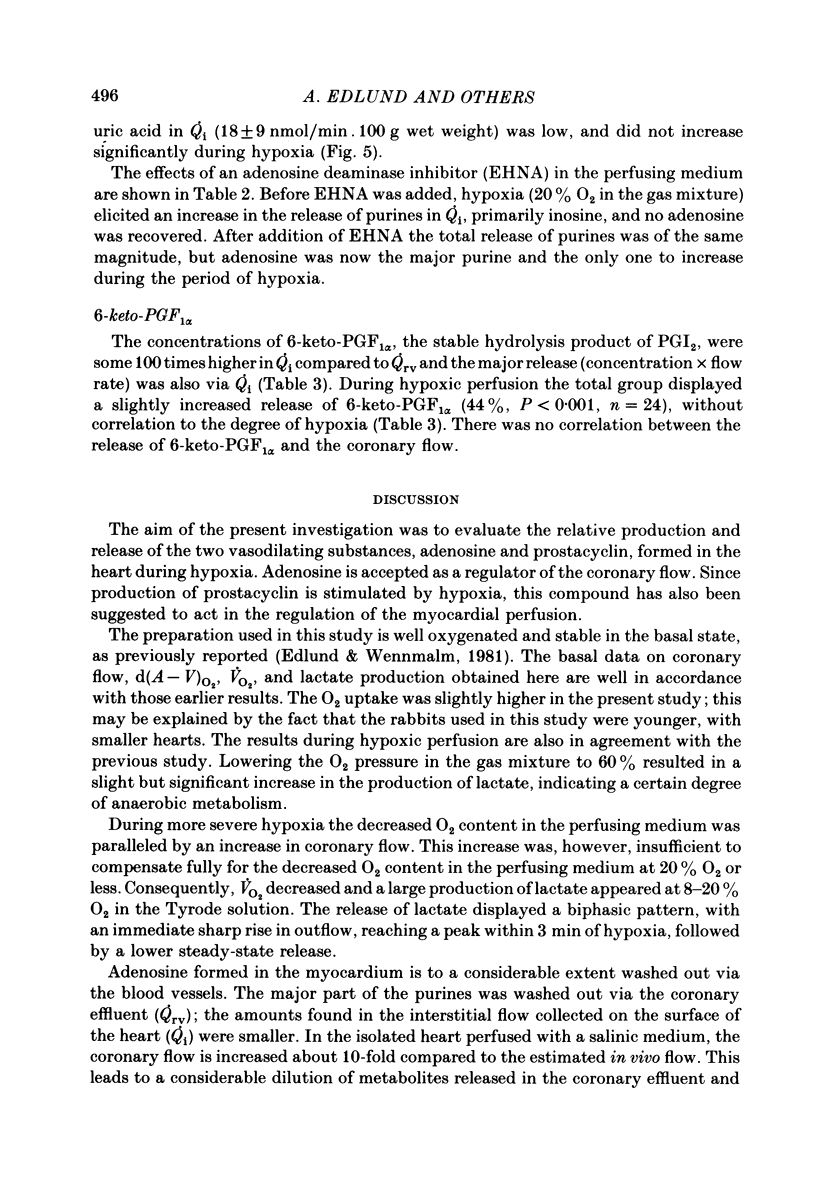
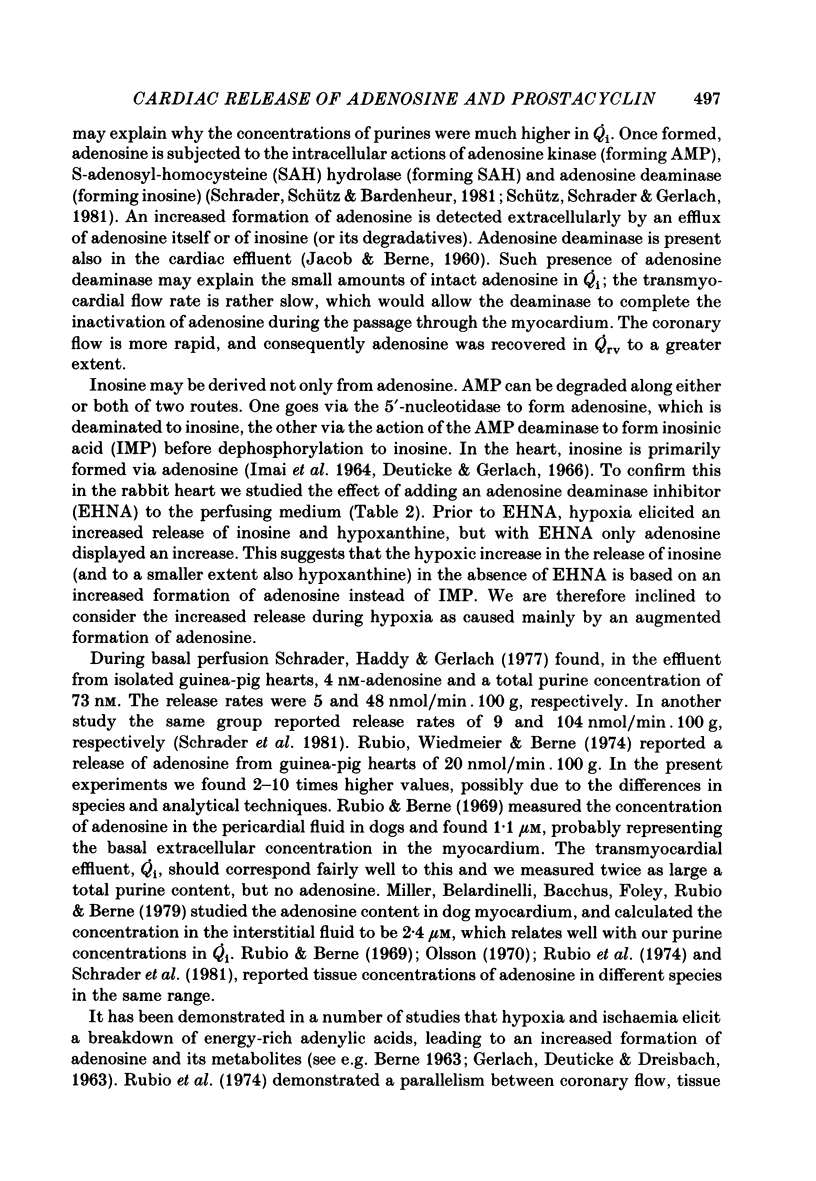
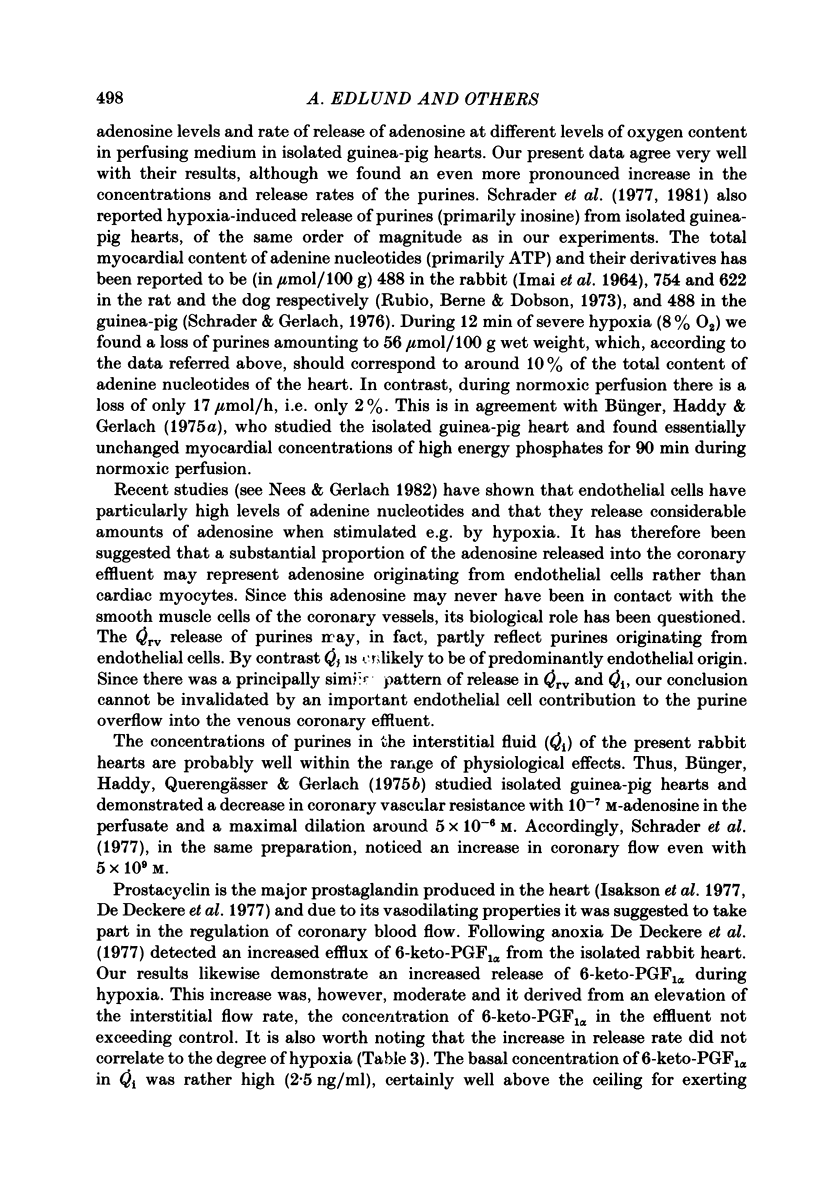
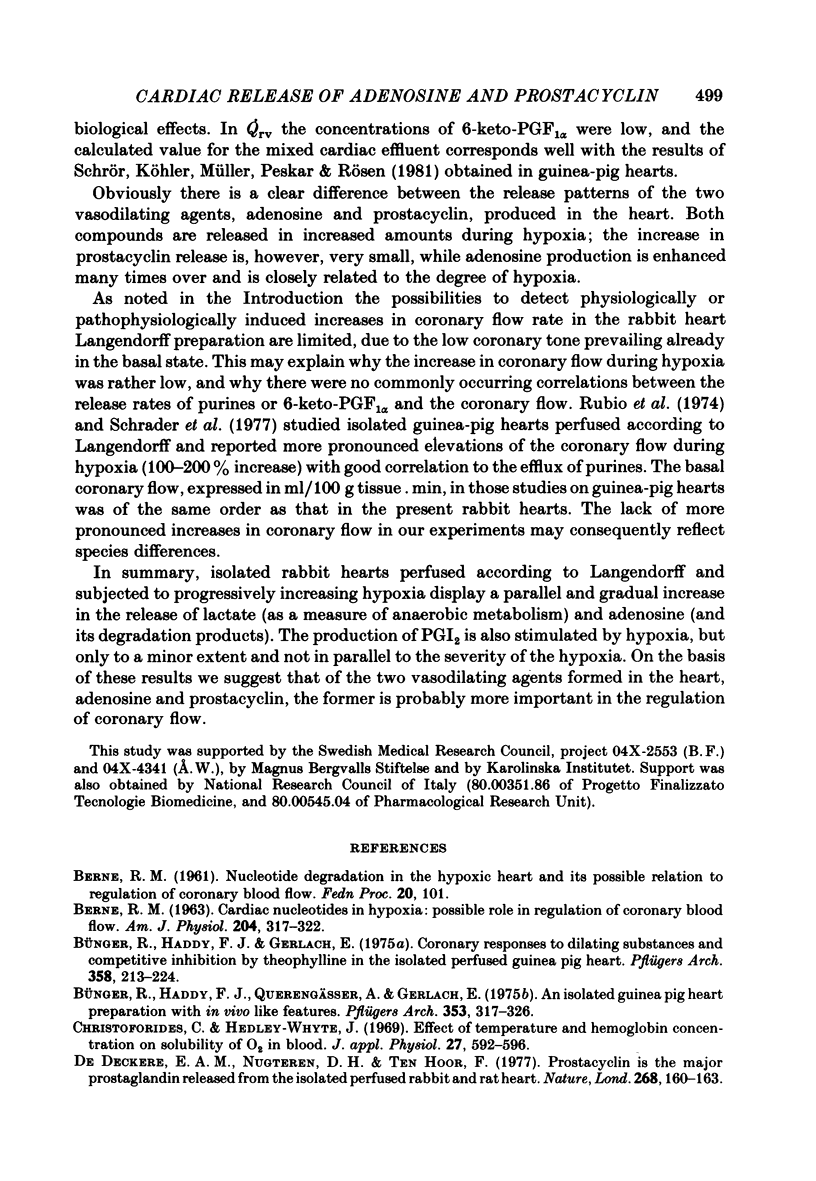
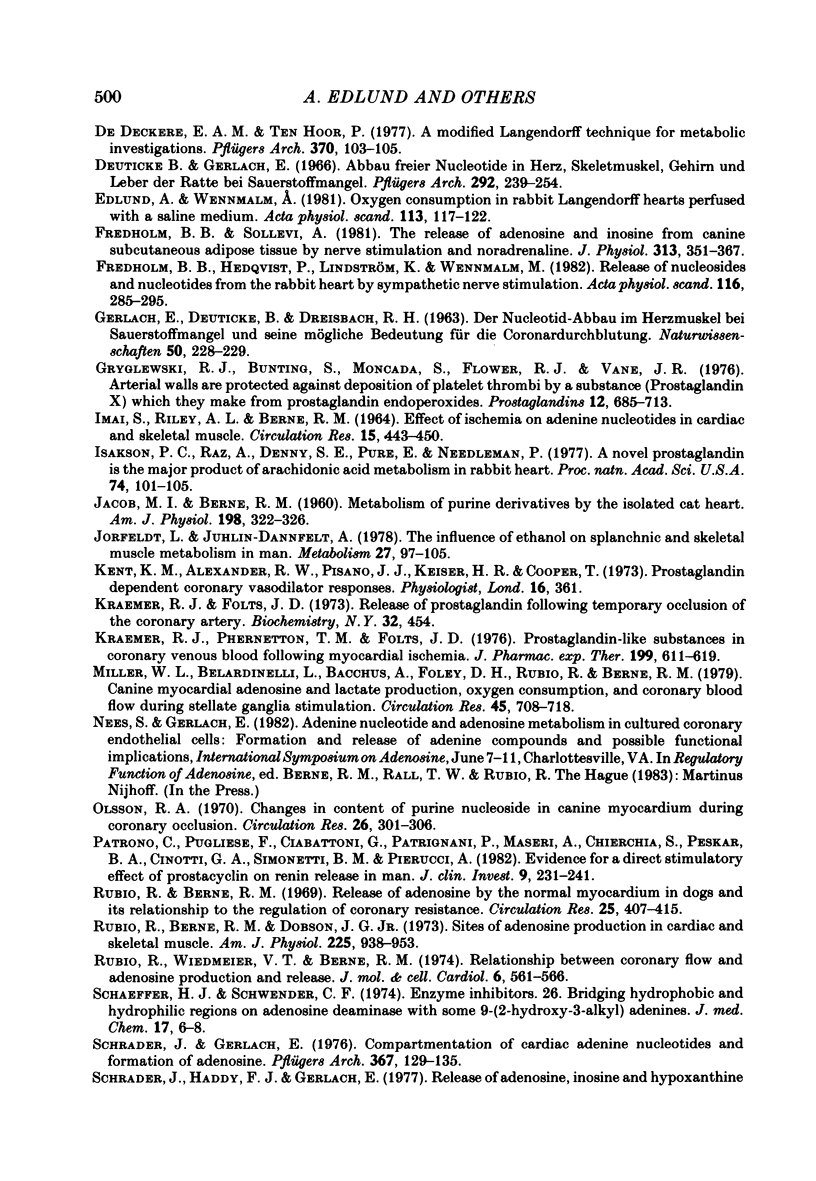
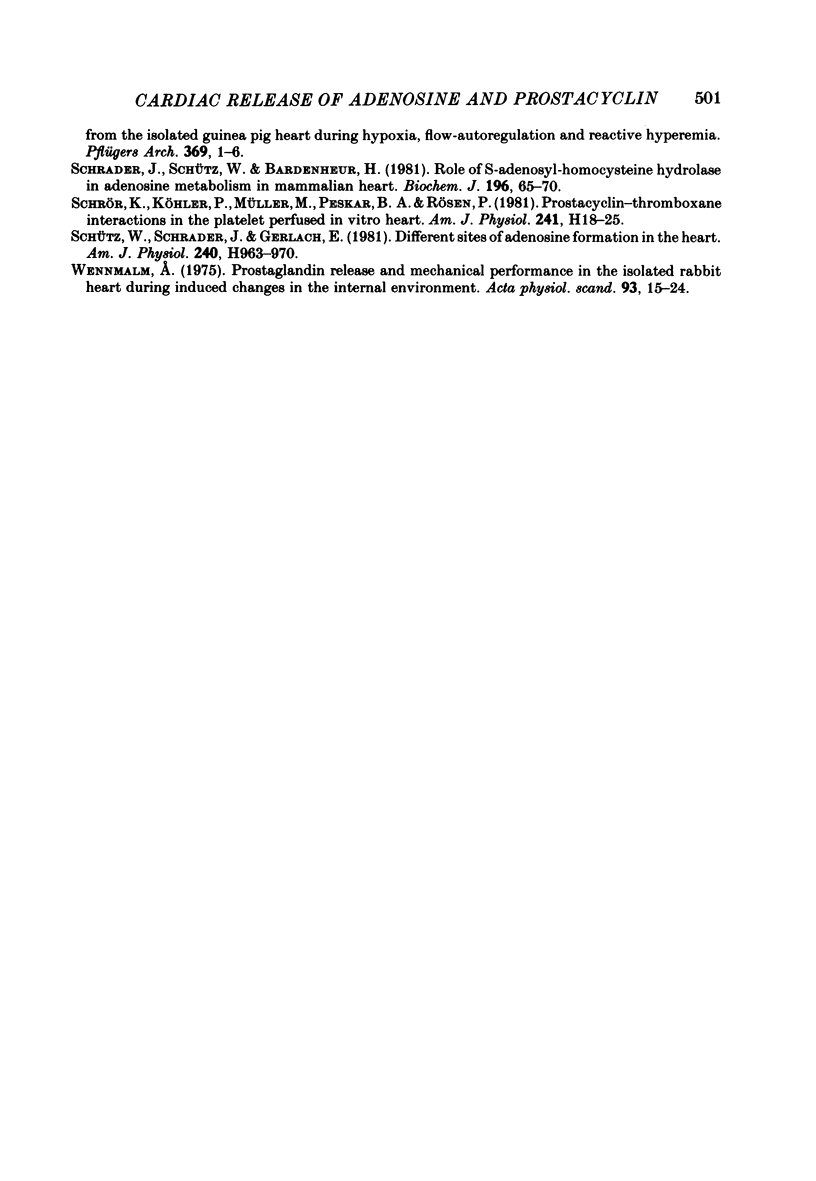
Selected References
These references are in PubMed. This may not be the complete list of references from this article.
- BERNE R. M. Cardiac nucleotides in hypoxia: possible role in regulation of coronary blood flow. Am J Physiol. 1963 Feb;204:317–322. doi: 10.1152/ajplegacy.1963.204.2.317. [DOI] [PubMed] [Google Scholar]
- Bünger R., Haddy F. J., Gerlach E. Coronary responses to dilating substances and competitive inhibition by theophylline in the isolated perfused guinea pig heart. Pflugers Arch. 1975 Jul 28;358(3):213–224. doi: 10.1007/BF00587218. [DOI] [PubMed] [Google Scholar]
- Bünger R., Haddy F. J., Querengässer A., Gerlach E. An isolated guinea pig heart preparation with in vivo like features. Pflugers Arch. 1975;353(4):317–326. doi: 10.1007/BF00587028. [DOI] [PubMed] [Google Scholar]
- Christoforides C., Hedley-Whyte J. Effect of temperature and hemoglobin concentration on solubility of O2 in blood. J Appl Physiol. 1969 Nov;27(5):592–596. doi: 10.1152/jappl.1969.27.5.592. [DOI] [PubMed] [Google Scholar]
- De Deckere E. A., Ten Hoor P. A modified Langendorff technique for metabolic investigations. Pflugers Arch. 1977 Jul 29;370(1):103–105. doi: 10.1007/BF00707954. [DOI] [PubMed] [Google Scholar]
- Deuticke B., Gerlach E., Dierkesmann R. Abbau freier Nucleotide in Herz, Skeletmuskel, Gehirn und Leber der Ratte bei Sauerstoffmangel. Pflugers Arch Gesamte Physiol Menschen Tiere. 1966;292(3):239–254. [PubMed] [Google Scholar]
- Edlund A., Wennmalm A. Oxygen consumption in rabbit Langendorff hearts perfused with a saline medium. Acta Physiol Scand. 1981 Sep;113(1):117–122. doi: 10.1111/j.1748-1716.1981.tb06870.x. [DOI] [PubMed] [Google Scholar]
- Fredholm B. B., Hedqvist P., Lindström K., Wennmalm M. Release of nucleosides and nucleotides from the rabbit heart by sympathetic nerve stimulation. Acta Physiol Scand. 1982 Nov;116(3):285–295. doi: 10.1111/j.1748-1716.1982.tb07142.x. [DOI] [PubMed] [Google Scholar]
- Fredholm B. B., Sollevi A. The release of adenosine and inosine from canine subcutaneous adipose tissue by nerve stimulation and noradrenaline. J Physiol. 1981;313:351–367. doi: 10.1113/jphysiol.1981.sp013670. [DOI] [PMC free article] [PubMed] [Google Scholar]
- Gryglewski R. J., Bunting S., Moncada S., Flower R. J., Vane J. R. Arterial walls are protected against deposition of platelet thrombi by a substance (prostaglandin X) which they make from prostaglandin endoperoxides. Prostaglandins. 1976 Nov;12(5):685–713. doi: 10.1016/0090-6980(76)90047-2. [DOI] [PubMed] [Google Scholar]
- IMAI S., RILEY A. L., BERNE R. M. EFFECT OF ISCHEMIA ON ADENINE NUCLEOTIDES IN CARDIAC AND SKELETAL MUSCLE. Circ Res. 1964 Nov;15:443–450. doi: 10.1161/01.res.15.5.443. [DOI] [PubMed] [Google Scholar]
- Isakson P. C., Raz A., Denny S. E., Pure E., Needleman P. A novel prostaglandin is the major product of arachidonic acid metabolism in rabbit heart. Proc Natl Acad Sci U S A. 1977 Jan;74(1):101–105. doi: 10.1073/pnas.74.1.101. [DOI] [PMC free article] [PubMed] [Google Scholar]
- JACOB M. I., BERNE R. M. Metabolism of purine derivatives by the isolated cat heart. Am J Physiol. 1960 Feb;198:322–326. doi: 10.1152/ajplegacy.1960.198.2.322. [DOI] [PubMed] [Google Scholar]
- Jorfeldt L., Juhlin-Dannfelt A. The influence of ethanol on splanchnic and skeletal muscle metabolism in man. Metabolism. 1978 Jan;27(1):97–106. doi: 10.1016/0026-0495(78)90128-2. [DOI] [PubMed] [Google Scholar]
- Kraemer R. J., Phernetton T. M., Folts J. D. Prostaglandin-like substances in coronary venous blood following myocardial ischemia. J Pharmacol Exp Ther. 1976 Dec;199(3):611–619. [PubMed] [Google Scholar]
- Miller W. L., Belardinelli L., Bacchus A., Foley D. H., Rubio R., Berne R. M. Canine myocardial adenosine and lactate production, oxygen consumption, and coronary blood flow during stellate ganglia stimulation. Circ Res. 1979 Dec;45(6):708–718. doi: 10.1161/01.res.45.6.708. [DOI] [PubMed] [Google Scholar]
- Olsson R. A. Changes in content of purine nucleoside in canine myocardium during coronary occlusion. Circ Res. 1970 Mar;26(3):301–306. doi: 10.1161/01.res.26.3.301. [DOI] [PubMed] [Google Scholar]
- Patrono C., Pugliese F., Ciabattoni G., Patrignani P., Maseri A., Chierchia S., Peskar B. A., Cinotti G. A., Simonetti B. M., Pierucci A. Evidence for a direct stimulatory effect of prostacyclin on renin release in man. J Clin Invest. 1982 Jan;69(1):231–239. doi: 10.1172/JCI110435. [DOI] [PMC free article] [PubMed] [Google Scholar]
- Rubio R., Berne R. M., Dobson J. G., Jr Sites of adenosine production in cardiac and skeletal muscle. Am J Physiol. 1973 Oct;225(4):938–953. doi: 10.1152/ajplegacy.1973.225.4.938. [DOI] [PubMed] [Google Scholar]
- Rubio R., Berne R. M. Release of adenosine by the normal myocardium in dogs and its relationship to the regulation of coronary resistance. Circ Res. 1969 Oct;25(4):407–415. doi: 10.1161/01.res.25.4.407. [DOI] [PubMed] [Google Scholar]
- Rubio R., Wiedmeier V. T., Berne R. M. Relationship between coronary flow and adenosine production and release. J Mol Cell Cardiol. 1974 Dec;6(6):561–566. doi: 10.1016/0022-2828(74)90036-4. [DOI] [PubMed] [Google Scholar]
- Schaeffer H. J., Schwender C. F. Enzyme inhibitors. 26. Bridging hydrophobic and hydrophilic regions on adenosine deaminase with some 9-(2-hydroxy-3-alkyl)adenines. J Med Chem. 1974 Jan;17(1):6–8. doi: 10.1021/jm00247a002. [DOI] [PubMed] [Google Scholar]
- Schrader J., Gerlach E. Compartmentation of cardiac adenine nucleotides and formation of adenosine. Pflugers Arch. 1976 Dec 28;367(2):129–135. doi: 10.1007/BF00585148. [DOI] [PubMed] [Google Scholar]
- Schrader J., Haddy F. J., Gerlach E. Release of adenosine, inosine and hypoxanthine from the isolated guinea pig heart during hypoxia, flow-autoregulation and reactive hyperemia. Pflugers Arch. 1977 May 6;369(1):1–6. doi: 10.1007/BF00580802. [DOI] [PubMed] [Google Scholar]
- Schrader J., Schütz W., Bardenheuer H. Role of S-adenosylhomocysteine hydrolase in adenosine metabolism in mammalian heart. Biochem J. 1981 Apr 15;196(1):65–70. doi: 10.1042/bj1960065. [DOI] [PMC free article] [PubMed] [Google Scholar]
- Schütz W., Schrader J., Gerlach E. Different sites of adenosine formation in the heart. Am J Physiol. 1981 Jun;240(6):H963–H970. doi: 10.1152/ajpheart.1981.240.6.H963. [DOI] [PubMed] [Google Scholar]
- Wennmalm A. Prostaglandin release and mechanical perfromance in the isolated rabbit heart during induced changes in the internal environment. Acta Physiol Scand. 1975 Jan;93(1):15–24. doi: 10.1111/j.1748-1716.1975.tb05786.x. [DOI] [PubMed] [Google Scholar]
- de Deckere E. A., Nugteren D. H., Ten Hoor F. Prostacyclin is the major prostaglandin released from the isolated perfused rabbit and rat heart. Nature. 1977 Jul 14;268(5616):160–163. doi: 10.1038/268160a0. [DOI] [PubMed] [Google Scholar]


